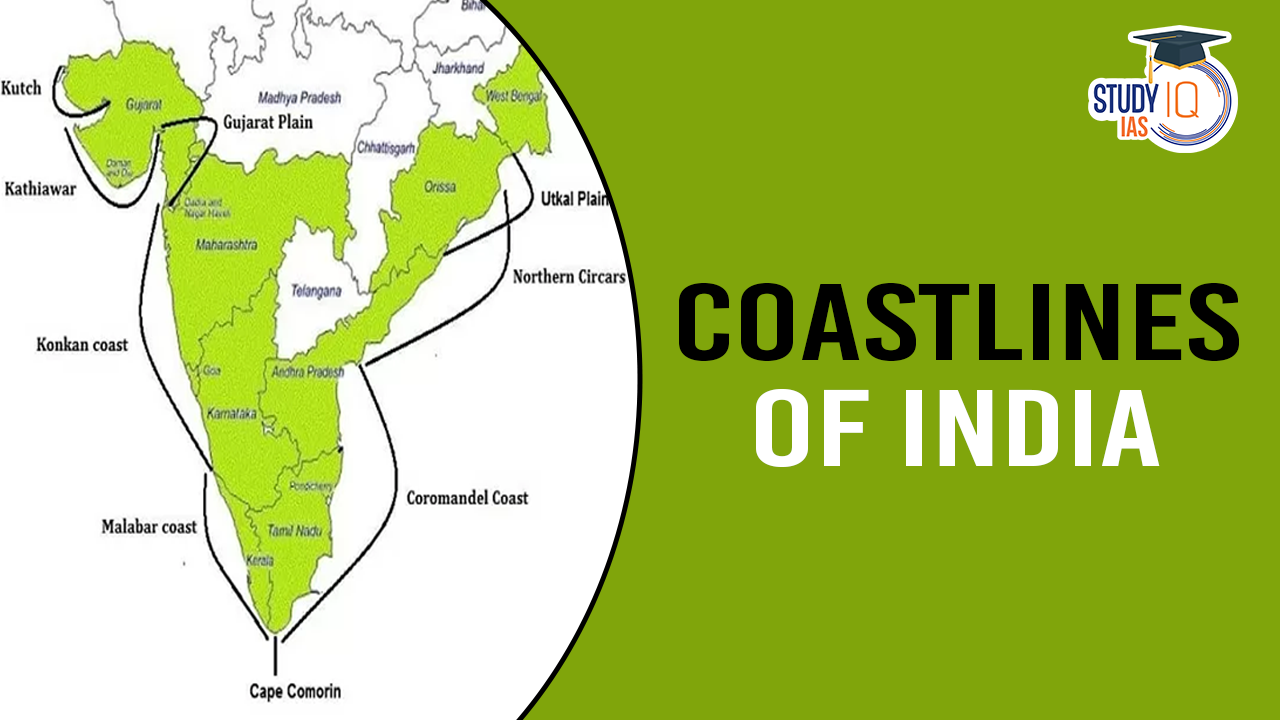Table of Contents
India, with its vast and diverse geography, boasts a coastline stretching over 7500 kilometers, touching 13 states and union territories. This expansive coastal stretch not only holds geographical significance but also plays a crucial role in shaping India’s economy, culture, and ecology. Let’s delve into the intricate details of India’s coastal plains, exploring their features, regional nuances, and significance.
Coastlines of India
India’s coastline, extending for 7516.6 kilometers, is not just a geographical feature but a vibrant tapestry of ecosystems, cultures, and economic activities. Shaped by geological processes and historical legacies, India’s coastal plains can be broadly classified into the Eastern and Western Coastal Plains, each with its own distinct characteristics and significance.
Eastern Coastal Plains
Stretching from West Bengal in the north to Tamil Nadu in the south, the Eastern Coastal Plains encompass the states of Andhra Pradesh, Odisha, and parts of Tamil Nadu. Fed by major rivers like the Mahanadi, Krishna, Godavari, and Cauvery, these plains boast fertile deltas that support thriving agricultural practices. The Krishna delta, known as the ‘Granary of South India,’ is a testament to the region’s agricultural prosperity.
The Eastern Coastal Plains are further divided into three distinct divisions:
- Utkal Coast: This region, spanning from Chilika Lake to Kolleru Lake, is characterized by its wide expanse and abundant rainfall. Rice, coconut, and banana are among the crops cultivated here, contributing to the region’s agricultural diversity.
- Andhra Coast: Stretching from Kolleru Lake to Pulicat Lake, the Andhra Coast serves as a basin for the Krishna and Godavari rivers. The fertile plains support extensive agriculture and are crucial for the region’s economy.
- Coromandel Coast: Extending from Pulicat Lake to Kanyakumari in Tamil Nadu, the Coromandel Coast experiences dry summers and rainy winters due to the northeast monsoons. The region’s agricultural productivity and coastal ecosystems make it a vital part of India’s coastline.
Western Coastal Plains
From Kerala in the south to Gujarat in the north, the Western Coastal Plains traverse the states of Karnataka, Goa, Maharashtra, and Gujarat. Spanning 1500 kilometers, these plains are narrower than their eastern counterparts but are rich in natural resources and biodiversity.
The Western Coastal Plains are divided into four distinctive sections:
- Kachchh and Kathiawar Coast: Formed by the silt deposits of the Indus River, Kachchh and Kathiawar were once gulf regions. Today, they are characterized by unique landscapes such as the Great Rann and the Little Rann, along with rich agricultural lands.
- Konkan Coast: Running from Daman to Goa, the Konkan Coast is renowned for its rice and cashew cultivation. The region’s scenic beauty, coupled with its marine biodiversity, attracts tourists from around the world.
- Karnataka Coast: Between Marmagaon and Mangalore lies the Karnataka Coast, known for its iron reserves and distinct marine topography. Waterfalls cascading down steep hillsides add to the region’s natural charm.
- Kerala Coast: Stretching from Mangalore to Kanyakumari, the Kerala Coast is characterized by its broad plains and backwater ecosystems. The Vembanad Lake, along with other lagoons and estuaries, contribute to the region’s ecological richness.
Significance
India’s coastal plains play a pivotal role in the country’s economy, environment, and cultural heritage. They support diverse ecosystems, agricultural practices, and industries such as fishing, tourism, and trade. The coastal regions act as gateways for international commerce, while also serving as hubs for cultural exchange and biodiversity conservation.
Conclusion
India’s coastal plains, with their rich diversity and economic significance, are vital components of the country’s landscape. Preserving and sustainably managing these coastal ecosystems is essential for the well-being of coastal communities, the conservation of biodiversity, and the overall prosperity of the nation. As India continues to evolve, its coastal plains remain integral to its identity and development trajectory.


 Solar Eclipse 2025, Meaning, Types, Date...
Solar Eclipse 2025, Meaning, Types, Date...
 Places in News for UPSC 2025 for Prelims...
Places in News for UPSC 2025 for Prelims...
 India Exports GI-Tagged Dalle Chilly fro...
India Exports GI-Tagged Dalle Chilly fro...





















